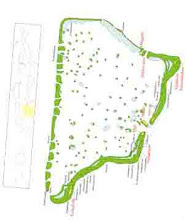
Tiles (called azulejos) are everywhere in Portugal. The azulejo (tile) is the most typical and widely used form of decoration in Portugal since the middle ages up to now. They decorate everything from walls of churches and monasteries, to palaces, ordinary houses, park seats, fountains, shops, and railway stations. The term azulejo comes from the Arabic word az-zulayj, meaning "polished stone." They often portray scenes from the history of the country, show its most ravishing sights, or simply serve as street signs, nameplates, or house numbers. Although they are not a Portuguese invention (the use of glazed tiles began in Egypt), they have been used more imaginatively and consistently in Portugal than in any other nation. They became an art form, and by the 18th century no other European country was producing as many tiles for such a variety of purposes and in so many different designs. Today, they still remain a very important part of the country's architecture. I took this photo in the first day of 2010 at Convent of Christ at Tomar. That is a good way to start the year. The famous window will come in another post.
















1 comentário:
Azulejos Portuguese ceramic tiles Tomar, Portugal such a nice and beautiful design and great article keep going on
Enviar um comentário